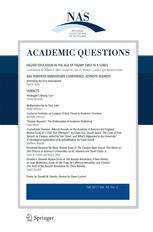Dan Subotnik is Professor of Law at the Jacob D. Fuchsberg Law Center at Touro College. He is the author of Toxic Diversity: Race, Gender, and Law Talk (NYU Press), among other works; [email protected].
President Obama’s statement in 2014 came as a bombshell: one in five women undergraduates is sexually assaulted during her college years.1 Much gnashing of teeth followed and today universities are still in a state of turbulence. A rape on campus makes the papers and can scare off parents and students. As a precondition for the possibility of rape, just the subject of campus sex “haunts campus security discourse,” writes professor Jennifer Doyle.2 The anxiety has only quickened under the influence of the #MeToo movement. But are American colleges and universities in the throes of a rape culture? If so, obviously, enforcement and educational measures are required. If not, fear of sexual assault needs to be allayed.
The one in five claim that Obama supported was not new for experts in the field and triggered (and continues to trigger) considerable commentary. For some, the statistic just confirmed the basis for existing fears. For others, the 20 percent rate is wildly overstated; the 2014 National Crime Victimization Survey (NCVS) conducted by the U.S. Bureau of Justice Statistics reported that for 2013, 4.4 college women per thousand (less than one-half of 1 percent per year) were subjected to attempted rape, forcible rape, and sexual assault other than rape.3 This would be one-tenth the rate implied by Obama of 5 percent (20 percent divided by four) per year. The authors of the FBI’s Uniform Crime Report (UCR) estimated for 2013 that twelve college women per thousand, or 1.2 percent annually, were subjected to forcible rape, attempted rape, and incapacitated rape.4 To put this in perspective, the Obama report’s 20 percent overall rate would probably mean, one analyst writes, that college women were “raped at a rate similar to women in Congo, where rape has been used as a weapon of war.”5
For still other observers, one in five considerably understates the problem. Activist groups like the Rape, Abuse and Incest National Network (RAINN) claim that only 310 out of every 1,000 rapes are reported to the police and that college-aged women have the lowest reporting rate. RAINN’s website posts U.S. Department of Justice statistics showing that only 20 percent of sexual assaults on college-aged women are reported to the police.6 For another, a study of sexual violence on campus for 2014-2015 sponsored by the U.S. Office of Violence Against Women (OVAW) reported that college women were subjected to completed sexual assault at a 10.3 percent rate and to completed sexual battery at a rate of 5.6 percent.7
Besides its failure to adequately define “completed” (as opposed to “uncompleted”) sex, the OVAW report raises all kinds of questions: For example, why doesn’t the report use traditional categories for classification? One cannot expect diverse reports to produce the same numbers, but why wouldn’t researchers settle on common categories of analysis? On a matter of such great social concern, some kind of clarification, if not reconciliation, is obviously needed. Not much along these lines can be achieved within the framework of a short article. Nor is a discussion of the validity of sexual assault claims possible here. (I wrote about this tricky matter in the summer 2018 issue of Academic Questions.8) So the goal here must be limited. I will focus mainly on “Clery Act” reporting, the required reporting mandated by the Jeanne Clery Disclosure of Campus Security Policy and Campus Crime Statistics Act which, as will be clear shortly, provides some good news about the college scene.
Among the major studies on campus sexual assault, NCVS is based on telephone surveys of young people at college, while the UCR is based on police reports compiled by the FBI. Clery reports, by contrast, are generated by university administrators based on their own knowledge and on reporting by students. In the Clery reports, police reports could probably be used as sources, but it is not at all clear to what extent that is happening.
First, a little background on Clery’s genesis. On April 5, 1986, a student named Jeanne Clery was raped and murdered in Stoughton Hall at Lehigh University by Joseph M. Henry, who was also a student. In 1990, in response to this crime, the Jeanne Clery Disclosure of Campus Security Policy and Campus Crime Statistics Act (Clery Act) was passed with the goal of prodding universities to improve safety measures on campus. A 2011 Dear Colleague Letter issued pursuant to the Act went so far as to warn universities that they were violating women’s rights not only when women were endangered but also when they were not “feeling safe.” The Clery Act itself required that universities provide adequate notice to prospective students about campus safety. What this meant is that schools had to report on actions taken to prevent violence and to inform students where they could go for help after the fact. Special and immediate safety concerns had to be reported to the community through crime alerts.
The main purpose of the Clery act was to inform students of the risks associated with individual schools. To this end, universities must file annual reports with the U.S. Department of Education listing not only sexual assaults but also other misconduct such as robbery, burglary, and non-sexual assaults, and these reports had to be made available on university websites or in other easily accessible locations. A study of aggregate Clery data for 2013 showed the effective annual rate of sexual assault to be .0288 percent (about 3 in 10,000), or 1/174th the rate suggested by the one in five claim.9
Knowing more about Clery reporting, then, seems imperative. A campus on tenterhooks may be a safe space, but it cannot be a productive or enjoyable one.
Because schools may vary in how they apply Clery standards, rather than attempt to update of aggregate data for American schools, I will focus on one school, Columbia University in New York, a school large enough to yield statistically significant data, and also my alma mater. To show that Columbia is not an outlier, I then turn briefly to Clery data from the University of North Carolina at Chapel Hill (UNC).
Columbia reports 26,260 full-time equivalent students and a total population—students, faculty, and employees—of 47,900. For 2016, the most current reporting year, Columbia listed twelve rapes (which includes attempts), six claims of rape deemed unfounded, eight cases of “fondling,” and fifteen cases of “dating violence” (which presumably falls short of rape and attempted rape). Once an act is characterized as misconduct, the university is prohibited from reversing the characterization without police support. Totaling the offenses leads to an overall sexual misconduct rate for Columbia of .00073 (47,900 divided into 35) or 7 out of 10,000 per year, a number higher than the national rate but, at .073 percent, still far from the one in five figure for four years of college, or 5 percent annually.
What accounts for Columbia’s low numbers? Columbia’s Clery-reported extensive program in sexual safety education might play a role. Columbia also has a code of conduct that, among other things, defines consent, requires that consent be affirmatively given for all sexual contact, and warns that alcohol and drug consumption can vitiate consent. The school has an orientation program for new students that deals with sexual violence in various settings, and the school offers escort and shuttle services for students who are fearful of violence at night. Columbia also has a public safety department (which has jurisdiction over all law-breaking) that employs almost over 150 people.
For victims, Columbia provides twenty-four-hour hotlines and safes spaces in the community, medical, legal, and counseling services, and a ”survivor advocate” if so desired. Columbia will usually accept and investigate complaints and, where it is requested, provide confidentiality for the complainant and alleged victimizer. Additionally, alleged victimizers will be judged on the basis of a preponderance of the evidence—rather than a more rigorous, harsher criminal-law-like standard. Of course, we can’t know how effective each of these initiatives is in limiting sexual assault. But the result is that in 2017 the National Council for Home Safety and Security ranked Columbia 22nd in public safety among 2000 colleges and universities as measured by police crime statistics. A large-scale study would be required to determine whether other schools have the same safety programs. But by way of comparison, at the large public university UNC Chapel Hill, the Clery report lists twenty-three rapes (including attempts), zero claims unfounded, seven instances of “forcible touching,” and fourteen incidents involving “dating violence.”
Any rape is one rape too many, but we know that college women are victimized at lower rates than the general population of college-age women.10 Why then don’t university leaders boast about their Clery numbers? One answer is that universities are engaged in a delicate balancing act. While marketing departments might brandish low Clery numbers to burnish schools’ public safety image, such low numbers would threaten the narratives upon which many academic departments, centers, and administrative functionaries are deeply invested, stirring virulent opposition from well-entrenched catastrophists and sex-as-male-dominance theorists.
The more important question, of course, is what to make of the Clery reports vs. Uniform Crime Reports disparity (12 per thousand). In principle, it should be much narrower. Columbia and UNC say explicitly that their Clery reports make some use of police data. On the other hand, Clery and police reports do not measure the same things. A Clery report would, for example, cover only assaults in close proximity to campus, while self-reports to police would include assaults at some remove from campus. Definitions of sexual assault likely also vary: Does over-the-clothes touching count as fondling? These, however, seem minor matters that would not begin to explain why the Columbia Clery report sexual assault rate of .00073 is so far removed from that ascribed generally by Obama to colleges (one in five female victimization).
Is it that female students prefer reporting to the police rather than to campus Title IX officials who compile Clery data? Hardly likely. One would think that a student would prefer to make her complaint to a female-dominated crisis center at her university, where the investigation would be homier and more sympathetic than one in a tough, bureaucratic police department. Is it that many students want to claim victimization through a sexual assault complaint? Also highly unlikely, but also only one of a number of pressing questions. Are students telling different stories to researchers and police than to campus officials? Conversely, are campus officials and police telling different stories to students? Does the reminder by activists that colleges lack subpoena powers explain anything? At what stage of the process does a complainant’s account become a Clery complaint?
Answers are elusive, and not only for the reasons already stated. More to the point, when asked for commentary on study gaps, campus sexual assault offices are skittish to the point of muteness. One can perhaps understand why. Better not to talk about sexual assault unless absolutely necessary.
Speculation is thus unavoidable. Which data sets are closer to the mark of general campus assault, self-reports and police reports, or the Clery reports for individual campuses? One might conclude that, with their incentives to play down the numbers, universities cannot be trusted to report reliably. The rub is that misleading Clery reports trigger financial penalties, including the possible loss of federal funding, a consequence that would be catastrophic. Also, Title IX staffs are large, with a wide variety occupational lines carrying disparate incentive structures and professional accountability mandates. At Columbia the Title IX staff (who also deal with matters other than assault) numbers twenty-three, not including the nine investigators in the Office of Public Safety. With so many hands in the Title IX pie, it seems unlikely that intentionally misleading reports would fully escape public notice.
All the efforts over the last twenty years toward uncovering campus sexual assault, then, seem to have left us in a state of tohubohu. But perhaps not entirely. The Clery report suggests the possibility that while America’s reputed “paranoid style” may have infected many critics of our universities, there is indeed a basis for better cheer on campus. For if the .0288 percent annual figure (3 per 10,000) for sexual assault is anywhere near accurate, and if for some inexplicable reason, reports such as OVAW’s are just plain wrong, not only Columbia but many schools are proving to be very safe spaces for women.
1 This famous datum probably derives from an online survey at two universities. Christopher R. Krebs et al., The Campus Sexual Assault Study (2007), National Criminal Justice Reference Service, https://www.ncjrs.gov/pdffiles1/nij/grants/221153.pdf
2 Jennifer Doyle, Campus Sex Campus Security (New York: Semiotext, 2015), 32.
3 Wendy McElroy, “Rape Culture Hysteria: Fixing the Damage Done Men and Women” (Vulgus Press: 2016), 176.
4 McElroy, 159.
5 Emily Yoffe, “The College Rape Overcorrection, Slate (December 2014), 7.
6 U.S. Department of Justice, Office of Justice Programs, Bureau of Justice Statistics, Rape and Sexual Victimization Among College-Aged Females, 1995-2013 (2014), found on RAINN’s website, https://www.rainn.org/statistics/criminal-justice-system.
7 U.S. Bureau of Justice Statistics, Campus Climate Survey Validation Study: Final Technical Report,” (Washington, D.C., 2016), by Chistopher Krebs et al., E6, https://www.bjs.gov./content/pub/pdf/ccsvsftr.pdf
8 Dan Subotnik, “Sexual assault and the Benefit of the Doubt,” Academic Questions 31, no. 2 (Summer 2018).
9 Corey Raeburn Yung, “Concealing Campus Sexual Assault: An Empirical Investigation,” Psychology, Public Policy and the Law 21, no. 1 (2015):1-9.
10 McElroy, 167.












